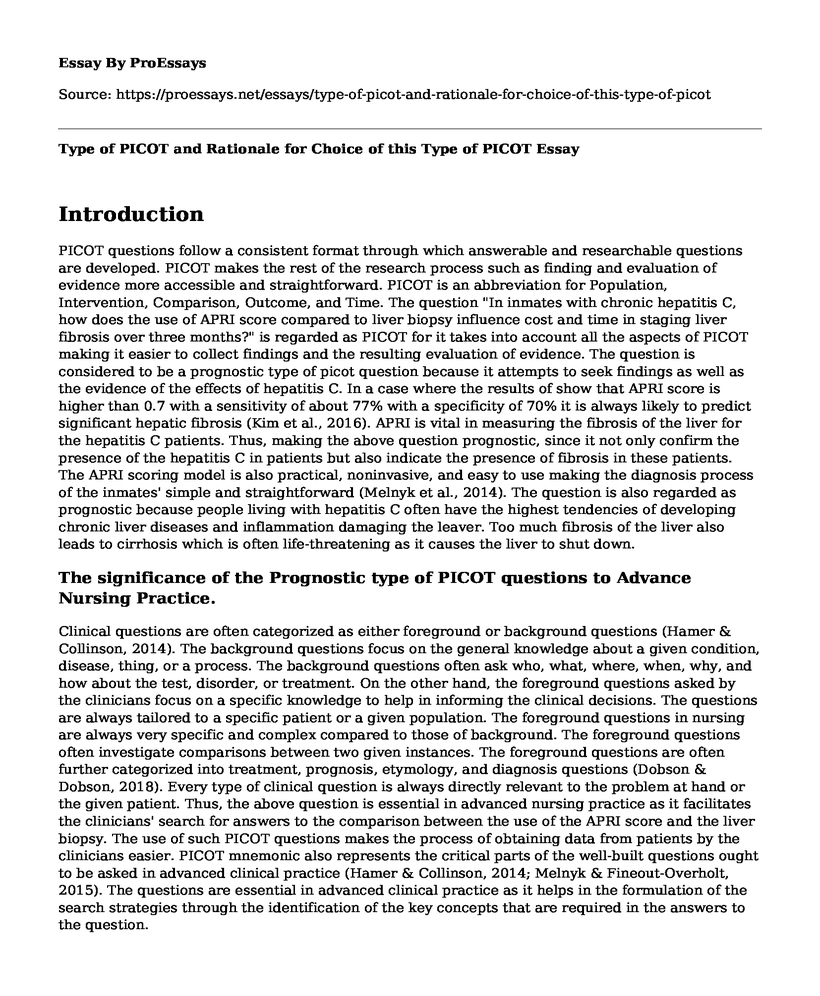Introduction
PICOT questions follow a consistent format through which answerable and researchable questions are developed. PICOT makes the rest of the research process such as finding and evaluation of evidence more accessible and straightforward. PICOT is an abbreviation for Population, Intervention, Comparison, Outcome, and Time. The question "In inmates with chronic hepatitis C, how does the use of APRI score compared to liver biopsy influence cost and time in staging liver fibrosis over three months?" is regarded as PICOT for it takes into account all the aspects of PICOT making it easier to collect findings and the resulting evaluation of evidence. The question is considered to be a prognostic type of picot question because it attempts to seek findings as well as the evidence of the effects of hepatitis C. In a case where the results of show that APRI score is higher than 0.7 with a sensitivity of about 77% with a specificity of 70% it is always likely to predict significant hepatic fibrosis (Kim et al., 2016). APRI is vital in measuring the fibrosis of the liver for the hepatitis C patients. Thus, making the above question prognostic, since it not only confirm the presence of the hepatitis C in patients but also indicate the presence of fibrosis in these patients. The APRI scoring model is also practical, noninvasive, and easy to use making the diagnosis process of the inmates' simple and straightforward (Melnyk et al., 2014). The question is also regarded as prognostic because people living with hepatitis C often have the highest tendencies of developing chronic liver diseases and inflammation damaging the leaver. Too much fibrosis of the liver also leads to cirrhosis which is often life-threatening as it causes the liver to shut down.
The significance of the Prognostic type of PICOT questions to Advance Nursing Practice.
Clinical questions are often categorized as either foreground or background questions (Hamer & Collinson, 2014). The background questions focus on the general knowledge about a given condition, disease, thing, or a process. The background questions often ask who, what, where, when, why, and how about the test, disorder, or treatment. On the other hand, the foreground questions asked by the clinicians focus on a specific knowledge to help in informing the clinical decisions. The questions are always tailored to a specific patient or a given population. The foreground questions in nursing are always very specific and complex compared to those of background. The foreground questions often investigate comparisons between two given instances. The foreground questions are often further categorized into treatment, prognosis, etymology, and diagnosis questions (Dobson & Dobson, 2018). Every type of clinical question is always directly relevant to the problem at hand or the given patient. Thus, the above question is essential in advanced nursing practice as it facilitates the clinicians' search for answers to the comparison between the use of the APRI score and the liver biopsy. The use of such PICOT questions makes the process of obtaining data from patients by the clinicians easier. PICOT mnemonic also represents the critical parts of the well-built questions ought to be asked in advanced clinical practice (Hamer & Collinson, 2014; Melnyk & Fineout-Overholt, 2015). The questions are essential in advanced clinical practice as it helps in the formulation of the search strategies through the identification of the key concepts that are required in the answers to the question.
References
Dobson, D., & Dobson, K. S. (2018). Evidence-based practice of cognitive-behavioral therapy. Guilford Publications.
Hamer, S., & Collinson, G. (2014). Achieving Evidence-Based Practice E-Book: A Handbook for Practitioners. Elsevier Health Sciences.
Harvey, G., & Kitson, A. (2015). Implementing evidence-based practice in healthcare: a facilitation guide. Routledge.
Kim, W. R., Berg, T., Asselah, T., Flisiak, R., Fung, S., Gordon, S. C., ... & Schall, R. E. A. (2016). Evaluation of APRI and FIB-4 scoring systems for non-invasive assessment of hepatic fibrosis in chronic hepatitis B patients. Journal of hepatology, 64(4), 773-780.
Melnyk, B., & Fineout-Overholt, E. (2015). Evidence-based practice in nursing & healthcare (3rd ed.). Wolters Kluwer Health.
Melnyk, B. M., GallagherFord, L., Long, L. E., & FineoutOverholt, E. (2014). The establishment of evidencebased practice competencies for practicing registered nurses and advanced practice nurses in realworld clinical settings: Proficiencies to improve healthcare quality, reliability, patient outcomes, and costs. Worldviews on EvidenceBased Nursing, 11(1), 5-15.
Cite this page
Type of PICOT and Rationale for Choice of this Type of PICOT. (2022, Jul 08). Retrieved from https://proessays.net/essays/type-of-picot-and-rationale-for-choice-of-this-type-of-picot
If you are the original author of this essay and no longer wish to have it published on the ProEssays website, please click below to request its removal:
- Multi-Agency Emergency Event Paper
- Pathophysiology of Polycystic Ovarian Syndrome Paper Example
- Schistosomiasis - Essay Sample
- Research Paper on Sleep Patterns
- Technology and Cancer Annotated Bibliography
- Essay Sample on Pro-Choice Abortion
- Julie Thomas: Anxiety, Heart Attack Risk & Life Disruption - Case Study







